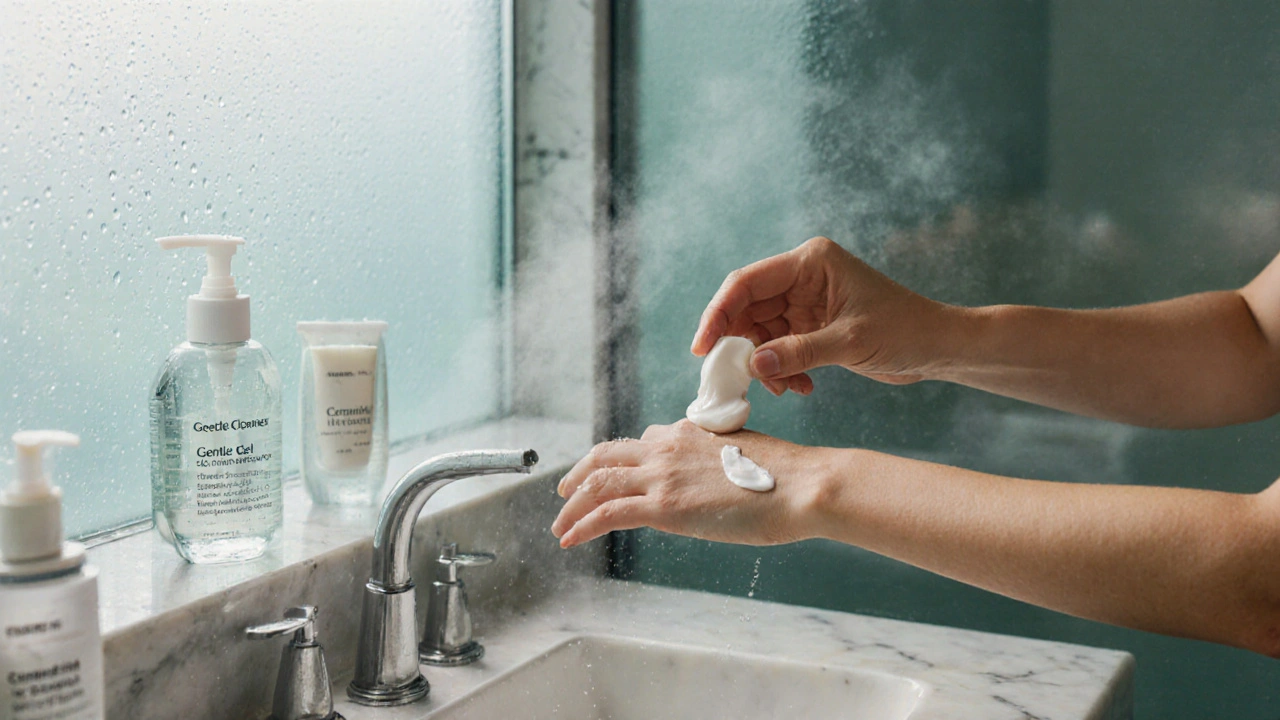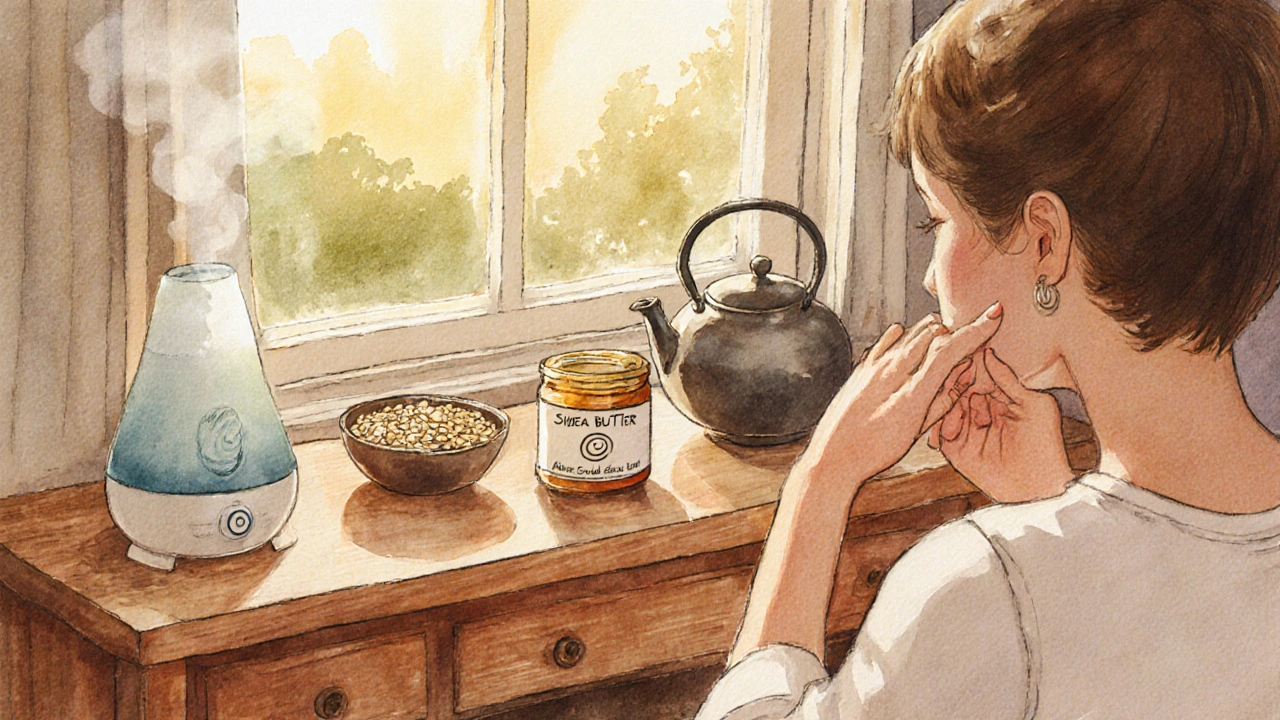Skin Barrier Health Checker
Assess Your Daily Skin Care Habits
Answer the following questions about your routine to determine if your skin barrier is at risk of breaking down.
Your Barrier Health Report
Tips to Strengthen Your Skin Barrier:
- Limit showers to once a day with lukewarm water
- Use a gentle, pH-balanced cleanser (pH 5.0-5.5)
- Apply moisturizer within 3 minutes after showering
- Consider using a humidifier indoors
- Choose moisturizers containing ceramides, cholesterol, and free fatty acids
Most of us think a rash is just a little irritation that will fade on its own. In reality, a rash often signals that the skin’s natural shield-its barrier-has broken down. When the barrier can’t keep out irritants, allergens, or excess water, the skin erupts into redness, itching, or bumps. Understanding how the barrier works, what weakens it, and how to rebuild it gives you a practical way to keep rashes at bay.
Key Takeaways
- The skin barrier is primarily the skin barrier formed by the stratum corneum and its lipid matrix.
- Loss of lipids, low filaggrin levels, or a high transepidermal water loss (TEWL) rate are the three main ways the barrier fails.
- Targeted moisturizers rich in ceramides, cholesterol, and free fatty acids restore barrier integrity in as little as two weeks.
- Everyday habits-short showers, gentle cleansers, and avoiding harsh chemicals-protect the barrier before a rash appears.
- Monitoring skin pH and TEWL gives a quick health check for future flare‑ups.
What the Skin Barrier Actually Is
In simple terms, the barrier is the outermost layer of the skin that stops water from escaping and blocks external aggressors. The technical name for this outer layer is the stratum corneum a thin, dead‑cell layer composed of flattened keratinocytes (corneocytes) embedded in a lipid matrix. Think of it like a brick wall: the corneocytes are the bricks, and the surrounding lipids act as mortar.
The mortar is made up of three main lipid families-ceramides, cholesterol, and free fatty acids-in roughly equal parts. When one of these components drops, the wall develops cracks, and irritants slip through.
How the Barrier Breaks Down
Three factors most commonly weaken the barrier:
- Loss of lipids. Harsh soaps, frequent washing, and hot water strip away the lipid mortar. Over time, the ratio of ceramides to cholesterol shifts, creating gaps.
- Filaggrin deficiency. Filaggrin a protein that helps bind water to corneocytes and breaks down into natural moisturizing factors (NMF) is the glue that keeps cells hydrated. Genetic mutations or chronic inflammation can lower filaggrin levels, making the skin dry and prone to cracking.
- Elevated transepidermal water loss (TEWL). Transepidemal water loss the amount of water vapor that escapes through the skin per hour is a direct read‑out of barrier integrity. When TEWL exceeds 10g/m²·h in adults, the skin is considered compromised.
When any of these three go off‑track, the skin becomes an open invitation for irritants that trigger conditions like eczema, contact dermatitis, or simple contact rashes.

Common Rash Triggers Linked to a Weak Barrier
Here are the everyday culprits that exploit a broken barrier:
- Soap and detergent residues. Surfactants dissolve lipids and raise skin pH.
- Temperature extremes. Hot showers evaporate water; cold, dry air pulls moisture out.
- Allergens. Nickel, fragrance, or fabric dyes can penetrate a compromised wall and start an immune response.
- Microbial overgrowth. When the barrier is weak, Staphylococcus aureus and Malassezia yeast bloom, leading to flare‑ups.
Notice a pattern? All of them either strip lipids, disrupt pH, or increase TEWL.
Rebuilding the Barrier: What a Good Moisturizer Should Contain
Moisturizers are the repair kits for the barrier, but not all are created equal. The most effective products follow the “triple‑lipid” rule: they supply ceramides, cholesterol, and free fatty acids in a 1:1:1 ratio.
| Ingredient | Primary Role | Typical % in Formula |
|---|---|---|
| Ceramides (e.g., Ceramide NP) | Restores lipid mortar | 3‑5% |
| Cholesterol | Stabilises lipid layers | 2‑4% |
| Free Fatty Acids (e.g., Linoleic Acid) | Improves flexibility | 1‑3% |
| Niacinamide | Boosts filaggrin production | 2‑4% |
| Humectants (Glycerin, Hyaluronic Acid) | Draws water into stratum corneum | 5‑10% |
When you choose a moisturizer a product designed to add water and lipids to the skin’s outer layer, look for these ingredients on the label. Products that advertise “barrier repair” usually meet the triple‑lipid criteria.
Application tips that speed recovery:
- Apply within three minutes of a shower while skin is still damp; seal in the water.
- Use a pea‑size amount for each hand, spreading thinly over the entire face and body.
- Re‑apply after washing hands or after any sport that causes sweat.
Daily Habits That Preserve the Barrier
Even the best moisturizer can’t fix a barrier that’s constantly being torn down. Adopt these simple routines:
- Short, lukewarm showers. Keep water under 38°C and limit each session to 5‑10 minutes.
- Gentle, pH‑balanced cleansers. Aim for a pH between 5.0 and 5.5; avoid sulfates and fragrance.
- Pat dry, don’t rub. Rubbing spreads friction‑induced micro‑tears.
- Humidify indoor air. Maintaining 40‑60% humidity reduces TEWL, especially in winter.
- Wear breathable fabrics. Cotton and bamboo let sweat evaporate without trapping moisture.
These habits keep the brick wall intact, so irritants stay out and the skin stays calm.

When to Seek Professional Help
If you notice any of the following, it’s time to see a dermatologist:
- Rash that spreads rapidly or covers more than 10% of body surface.
- Painful blisters, oozing, or crusting.
- Persistent itching that disrupts sleep for more than a week.
- Family history of atopic dermatitis combined with personal flare‑ups.
Doctors can measure TEWL with a handheld probe, test for filaggrin mutations, or prescribe prescription‑strength barrier creams that contain higher doses of ceramides (up to 10%). Early intervention often prevents chronic eczema.
Quick DIY Barrier Boosters
For those who love a hands‑on approach, here are three easy recipes that complement store‑bought moisturizers:
- Olive‑Oil + Beeswax Balm - 2parts extra‑virgin olive oil, 1part beeswax, a few drops of vitaminE. Melt, pour into a jar, and let cool. Olive oil supplies fatty acids; beeswax adds occlusion.
- Shea‑Butter + Ceramide Powder - 1cup shea butter, 1tsp ceramide NP powder. Warm, mix, and store. Shea butter is rich in cholesterol and fatty acids.
- Oatmeal Water Spray - Steep ½cup colloidal oatmeal in 2cups hot water for 15minutes, strain, and pour into a spray bottle. Use after shower to calm inflammation and replenish NMF.
These DIYs aren’t replacements for clinically formulated products, but they give an extra lipid boost on days when your skin feels extra tight.
Frequently Asked Questions
How often should I apply a moisturizer to keep my skin barrier healthy?
For most people, twice a day-once after a morning wash and once before bed-covers the basic need. If you shower or swim, reapply within a few minutes to lock in moisture.
Can I use any cream to repair my barrier, or do I need a specific formula?
Look for a product that contains the three core lipids-ceramides, cholesterol, and free fatty acids-in roughly equal amounts. Anything missing one of those components will only give partial repair.
Is a high‑pH cleanser always bad for the skin barrier?
Yes, a pH above 6.0 can disrupt the acid mantle, weakening lipid cohesion and raising TEWL. Choose cleansers labeled ‘pH‑balanced’ or with a pH of 5.0‑5.5.
My child has frequent rashes. Can improving the barrier help?
Absolutely. Children often have lower ceramide levels. A gentle, fragrance‑free moisturizer with ceramides applied after baths can reduce flare‑ups dramatically.
What’s the best way to measure my skin’s TEWL at home?
Home TEWL meters are available for under $200, but a simpler proxy is the “pinch test”: press a fingertip to the skin for a few seconds. If the skin feels tight or puckers, TEWL is likely elevated.






I’m surprised nobody mentioned that boiling water for showers actually strips your skin’s natural oils :)